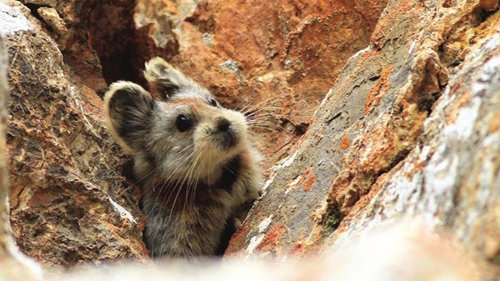For the past three decades, Li Weidong, aged 63 and a native of Xinjiang Uyghur Autonomous Region, has been searching for and protecting an animal endemic to the Tianshan region of Northwest China that is rarer than giant pandas.

Li Weidong in a speech
In 1983, Li discovered the Ili pika, a furry mouse-like animal from the pika family, in the rocks of the Tianshan Mountains. For the next 35 years, Li devoted himself to the protection and conservation of the shrinking species, which numbers fewer than 1,000 in China.
This July, he led a team to Xinjiang's Jinghe and Nilka counties for an investigation into the Ili pika's habitat. Since 2002, Li has been doing such field surveys once every four years. However, this might be his last time due to his age.
"Field studies require us to work on top of the Tianshan Mountains. At my age, I can only work several more years. I hope more young people can succeed our job," he told the audience on Yixi, a speech sharing platform similar to TedX.
Finding the Ili pika

An Ili pika Photos: screenshot from Yixi
One morning in July 1983, when Li, then an epidemic prevention officer, was doing field work in Nilka county, Xinjiang, he accidentally spotted a small furry animal racing past in front him in the rocks of the Tianshan Mountains.
Back then, Li's job was to search for rodents in rural areas and check if they carried any plague or other diseases. But the moment he saw the animal that looked like a cross between a mouse and a rabbit with big round ears, round eyes and a small tail, he knew it was different from anything he had ever seen.
He brought a sample of the animal down from the mountains, and checked all the lists of rodents. He didn't find a single animal that matched the one he just saw. He then consulted experts from the Chinese Academy of Sciences, and no one knew what it was.
Li realized that he may have found a new species. But only one sample wasn't enough. In the three years that followed, Li searched for the animal in the Tianshan Mountains, hoping he could find more of it to prove the existence of the species.
Through his research, Li managed to piece together the traits of the animal. It lives in an altitude between 2,800 meters and 4,100 meters on the Tianshan Mountains, doesn't drink, and it feeds on rare mountain vegetation such as Tianshan xuelian, a rare white flower, and Arctic root. They are solitary animals. Li had never seen two Ili pikas appear at the same time.
The high attitude of their habitat means Li often have to climb mountains to search for the animal.
He usually rides a horse to find the Ili pika on top of the mountains. Once, due to heavy mist, he got lost in the mountains at an altitude of 3,400 meters. After the mist cleared, he suddenly spotted the animal again.
Since Li was born and raised in Ili, Li decided to name the animal Ili pika.
In order to learn more about their living range, habitat and traits, Li changed his job from the disease prevention department to field research on the animal.
Over the past three decades, he went through almost every inch of the Tianshan Mountains in order to study the habitat of the Ili pika.
Sanctuary needed
From 1992 to 2014, despite his efforts to search for the animal, Li and his team didn't spot a single Ili pika in the wild, an alarming signal. Over the past 35 years, Li estimated the population of Ili pika has shrunk from 3,300 in 1992 to an estimated less than 1,000.
Over time, Li's attitude toward how to preserve the animal changed.
In the beginning, Li did not want the Ili pika to be known to the outside world as he feared the cute animal would attract poachers or visitors who want to see or breed it. His philosophy was no interference and no sanctuary for the animals - allowing them to live freely.
However, climate change and environmental changes brought a crisis to the rare animal. As the area of glaciers in the Tianshan Mountains shrank, and as grasslands decline, herdsmen had to climb higher and higher up the mountain to walk their herds.
This brought shepherds, an enemy of the Ili pika. The animals are also threatened by inbreeding and natural predators such as snow leopards.
In 2002, he found that among the 14 observation points located in seven cities and counties to the south and north of the Tianshan Mountains, the Ili pika could only be observed in two of these observation points.
"With 71 percent of their habitat lost, their population dropped quickly and this is a very dangerous situation," Li told China Youth Daily.
In 2005, the Ili pika was included in China's Redbook of endangered animals. In 2008, it was listed as endangered on the International Union for the Conservation of Nature (IUCN) Red List.
Starting from 2015, Li established a workshop on the protection and conservation of the Ili pika. He managed to get the support of the local government to establish two sanctuaries for the animal.
Many herdsman in the sanctuary in Jinghe have now become volunteers at his workshop. They help Li look after the cameras set up in the wild to observe the animal, and prevent poachers from entering.
Li also invited designers to turn the image of the Ili pika into cartoons so as to attract the attention of young people, so they would value and help protect the animal.


